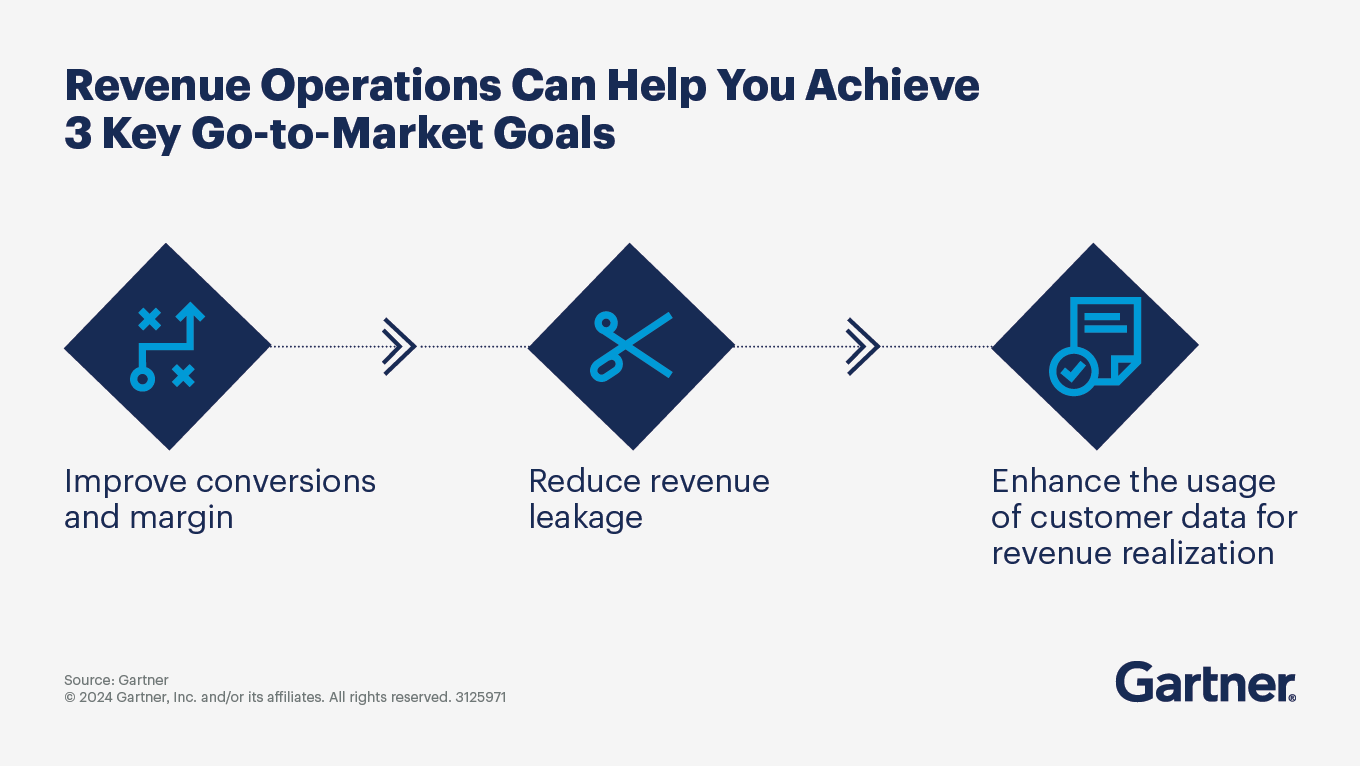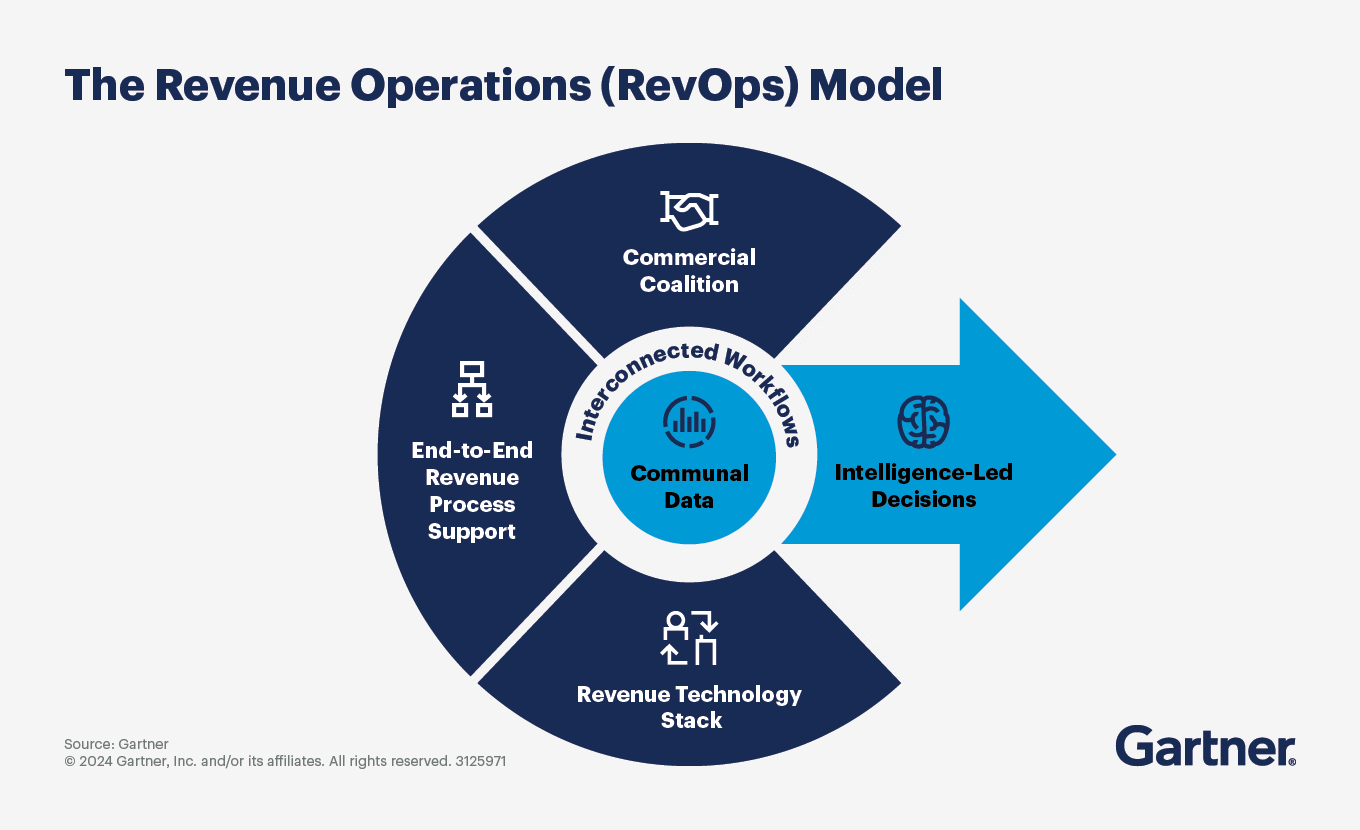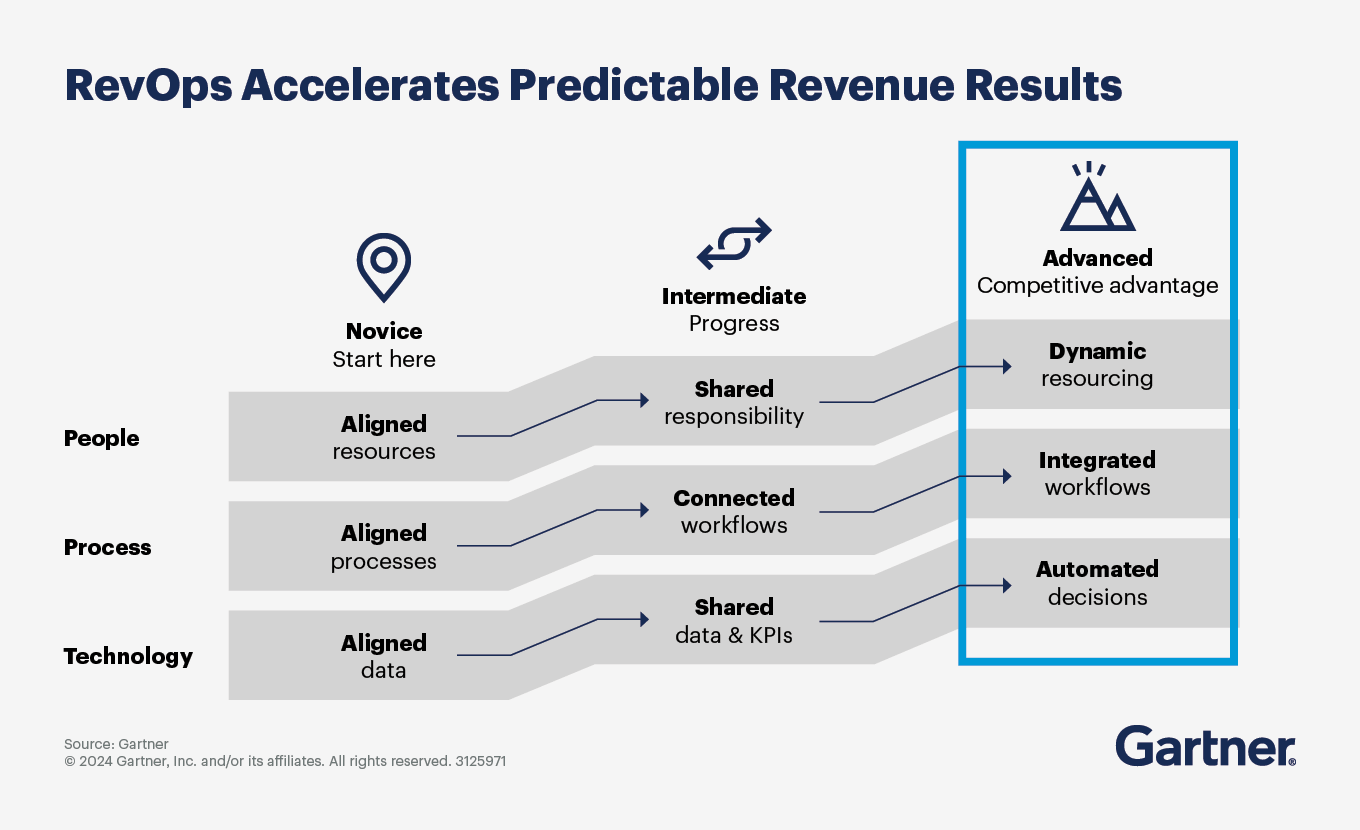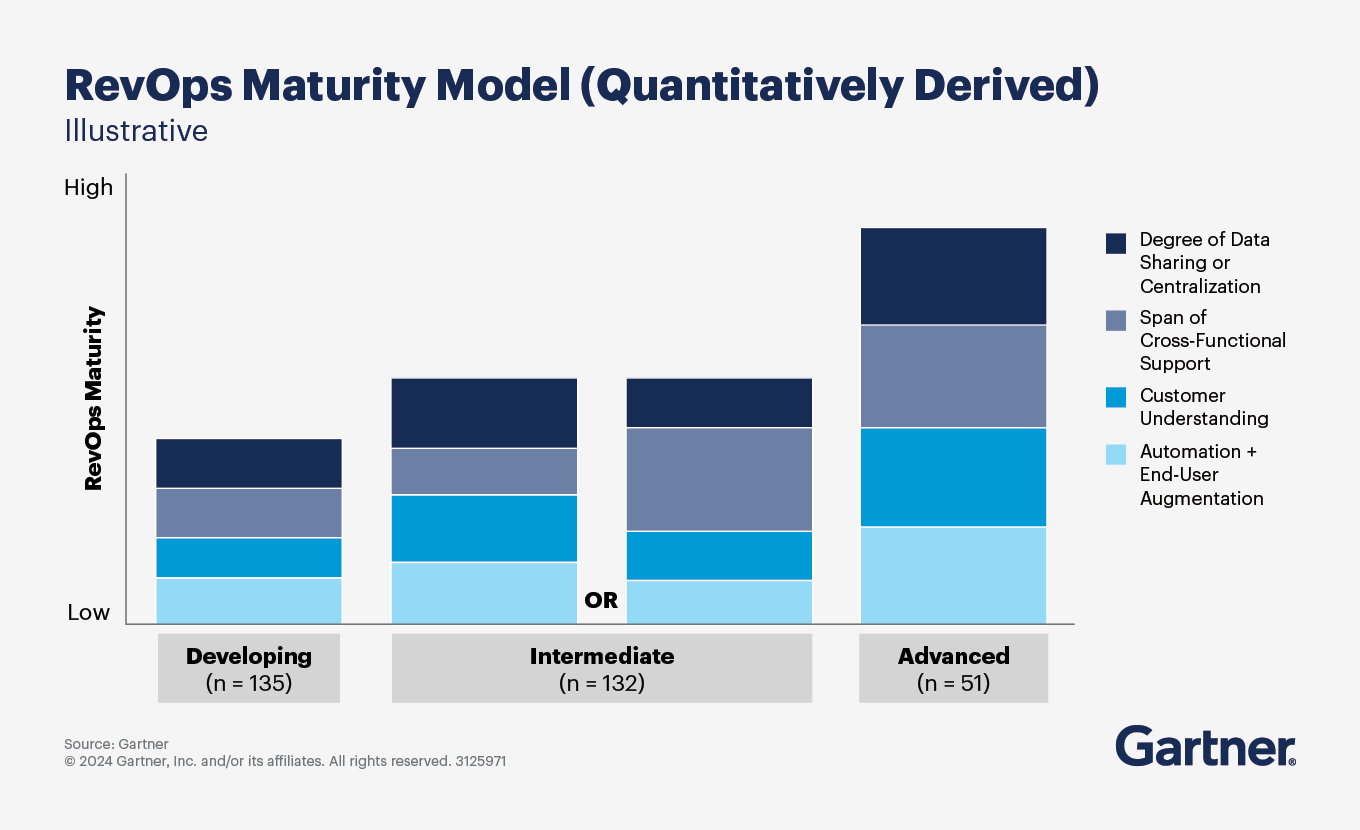Prepare, implement and advance RevOps for a fully optimized, buyer-centric go-to-market operation.
- Gartner client? Log in for personalized search results.
Revenue Operations (RevOps): Best Practices to Grow Your Business
RevOps is more viable than ever. Learn the practices that drive greater growth.
By 2026, 75% of the highest-growth companies will adopt a RevOps model, up from less than 30% today. Download “Is It Time for RevOps?” to gauge your organization’s readiness and learn the best practices for optimizing revenue operations processes that can help you:
Improve conversions and margin
Reduce revenue leakage
Optimize use of customer data to realize revenue
Transform GTM strategy and performance through RevOps
Use revenue operations to unify the end-to-end buyer journey and optimize revenue results. Sales leaders focus on the following areas to advance on the RevOps journey.
Preparing for RevOps
Implementing RevOps
Maturing RevOps
Adopt revenue operations principles to drive commitment to transformation
The term “revenue operations” (RevOps) has had multiple definitions. Some organizations view it as a title change, others as an organizational structure or a software category. None of these quite capture its impact.
Revenue operations is an end-to-end model that unifies customer engagement across functions and integrates people, processes and technology across the business to:
Operate more predictably and efficiently
Collect data across the entire revenue process
View the data through a trusted, communal source
The goal of revenue operations is to fuel data-led decisions and automate workflows to optimize and increase revenue production. RevOps succeeds in this by gathering a coalition of GTM stakeholders whose functions remain separate but whose operations are integrated and aligned to perform their specific revenue-related tasks.
The revenue operations model delivers the following benefits:
Efficiency. An interconnected, fully visible revenue process supports the full customer life cycle, allowing you to pinpoint and address any roadblocks throughout the process.
Predictability. Key milestones that drive the revenue models are assigned ownership, benchmarked and monitored to ensure consistent performance.
Elasticity. Revenue operations supports multiple routes to market. These routes can be dynamically scaled up or down as needed in response to shifting priorities.
Resiliency. Revenue operations allows you to proactively identify potential revenue disruptions and make early adjustments to avoid them.
Sales leaders play a pivotal leadership role in revenue operations. To prepare your organization for the revenue operations journey, focus on the following steps to streamline RevOps:
Map buyer journeys and customer life cycles with a focus on customer awareness and empathy.
Identify routes to market that will support these customers and their journeys.
Align GTM stakeholders on key revenue-generating milestones and metrics (i.e., the customer life cycle).
Identify internal workflows required to support the customer life cycle.
Establish data and analytics governance to deliver on the promise of revenue-influencing decisions.
Improve data literacy among stakeholders who use analytics.
Progressively identify and execute on viable revenue operations improvements
The need to maximize revenue impact across the entire customer life cycle is clear to most sales leaders. But traditional go-to-market (GTM) models don’t allow for a complete view of customer activity and buying behaviors. Typical challenges in these traditional models include:
Functional silos — each with its own data, workflows, KPI definitions and priorities
Limited visibility and data capture of the customer journey postpurchase
Lack of revenue technology, siloed software and/or underutilized technology investments
The revenue operations model addresses these challenges — and revenue operations doesn’t need to start with a large organizational transformation. You can implement revenue operations at any level and in any GTM function. For example:
Some companies initiate revenue operations by integrating the people in their operational teams.
Others focus on integrating cross-functional processes.
Some start by aligning sales and marketing, perhaps in a small region or product line.
Others choose to form a commercial coalition of stakeholders in operations.
In short, many options exist on the path toward revenue operations. Choose what is most actionable for your organization — and as you build comprehensive RevOps strategies, consider the following steps:
Align. Create a commercial coalition of GTM stakeholders and partner with them to define your RevOps vision and roadmap that focuses on setting up revenue-facing roles, revenue-generating milestones, data and analytics strategy, and technology.
Map. Design an end-to-end revenue process and internal workflows to support revenue-generating milestones, interaction points and metrics across different routes to market. This will provide you with the total visibility required to make insight-led decisions that drive positive business outcomes.
Integrate. Set up a centralized source of data and insights that integrates relevant data from finance, marketing, customer success and sales.
Drive commitment to RevOps transformation to maximize its potential
Companies with advanced-maturity RevOps functions are twice as likely to exceed revenue goals and 2.3 times as likely to exceed profit goals compared to companies with intermediate or developing maturity.
A mature RevOps function enables better GTM operational alignment and integration to ensure customer centricity and seamless supplier support. It secures GTM teams’ visibility into the entire sales pipeline and equips them with insights and tools to address issues in real time. This allows the front-end sales team to focus on core selling tasks — such as engaging new prospects and closing new business.
Mature RevOps also equips marketing with key data and insights across revenue-generating functions. This helps marketing create consistent, high-quality messaging and a value-driven brand perception, run successful customer experience initiatives and improve overall customer engagement.
Mature RevOps also benefits customer service, with better focus on customer needs and channel strategy, which improves the likelihood of upselling and retention.
The RevOps maturity model consists of three stages:
The developing maturity stage consists of end-to-end revenue processes defined with functional processes and platforms still in use and growing cross-functional alignment.
The intermediate maturity stage consists of well-defined revenue processes with moderate levels of data sharing and customer understanding. This stage provides broad cross-functional support or sophisticated customer understanding but limited cross-functional support.
The advanced maturity stage consists of end-to-end revenue processes mapped to the customer buying journey and supported by sophisticated levels of data centralization and customer understanding. This stage provides broad cross-functional support.
If your organization already has a RevOps model in place, carefully determine where you are on the RevOps maturity journey to determine how to move forward. By ensuring a smooth transition between RevOps maturity stages, you can reduce the risk of disrupting revenue-generating activities and wasting precious resources as business conditions evolve.
Some questions to consider as you determine your next steps include:
Does my RevOps vision align with GTM strategy?
What key actions and resources can ensure alignment among sales, marketing and customer success?
What is the level of quality and availability of RevOps data across the customer life cycle?
Which teams will make up RevOps, and what will each team be responsible for?
What are the highest-priority use cases for RevOps?
Attend a Conference
Join Gartner experts and your peers to accelerate growth
Gather alongside your peers in Las Vegas to gain insight on emerging trends, receive one-on-one guidance from a Gartner expert and create a strategy to tackle your priorities head-on.
Gartner CSO & Sales Leader Conference
Las Vegas, NV

Revenue operations (RevOps) FAQs
What is revenue operations (RevOps)?
Revenue operations (RevOps) is a business function that aligns sales, marketing and customer success teams to drive revenue growth. By breaking down silos, it ensures seamless collaboration, optimizes processes and leverages data for better decision making. RevOps aims to create a unified strategy that enhances customer experience, improves efficiency and maximizes revenue. Think of it as a holistic approach to managing and accelerating the entire revenue life cycle.
Why is RevOps important for business growth?
RevOps is crucial for business growth because it aligns sales, marketing and customer success teams, ensuring they work together seamlessly. By leveraging data and optimizing processes, RevOps enables better decision making and more effective strategies. Ultimately, it drives consistent revenue growth, maximizes resources and helps the business scale more effectively.
How can RevOps improve sales and marketing alignment?
RevOps improves sales and marketing alignment by creating unified goals and metrics, ensuring both teams work toward the same objectives. It streamlines processes, enhances communication and leverages shared data for better insights. By breaking down silos, RevOps fosters collaboration, improves lead management and ensures a seamless customer journey from marketing to sales. This alignment ultimately drives more efficient and effective revenue growth.
Drive stronger performance on your mission-critical priorities.



